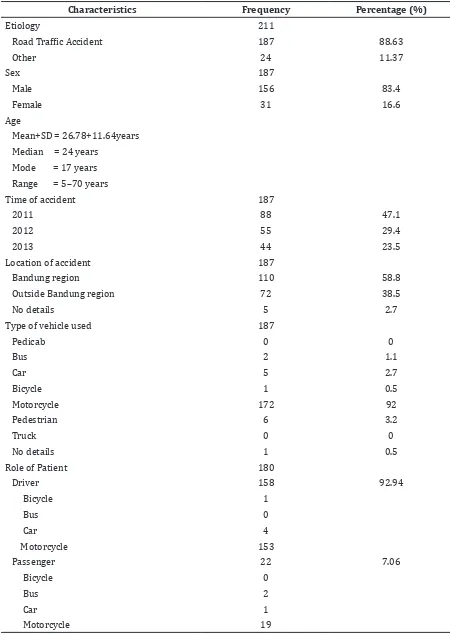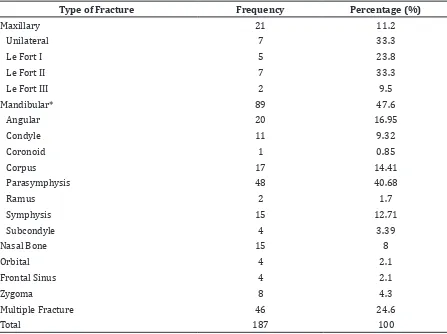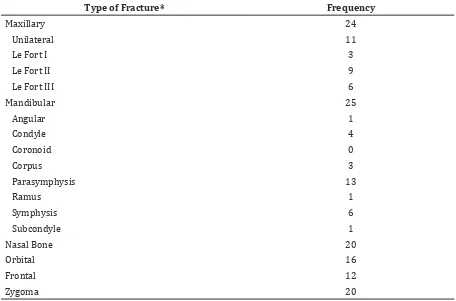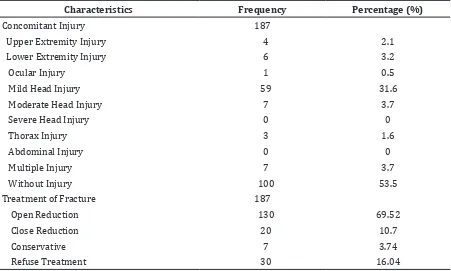Characteristics of Maxillofacial Fractures Resulting from Road Traffic
Accidents at Dr. Hasan Sadikin General Hospital
Oldi Caesario,1 Shinta Fitri Boesoirie,2 Alwin Tahid3
1Faculty of Medicine Universitas Padjadjaran, 2Department of Otorhinolaryngology-Head and Neck Surgery Faculty of Medicine Universitas Padjadjaran/Dr. Hasan Sadikin General Hospital Bandung, 3Department of Anatomy, Cell Biology and Physiology Faculty of Medicine Universitas
Padjadjaran
Abstract
Background: Maxillofacial fracture is a serious injury in the head region which is frequently found in the emergency room. In Indonesia, the road traffic accident is the main etiology. Epidemiological assessments are important to assess trends and set the priorities for treatment and prevention of the injury. This study was conducted to identify the characteristics of maxillofacial fracture resulting from road traffic accidents. Methods: This descriptive retrospective study involved hospitalized patients with maxillofacial fracture resulting from road traffic accidents at Dr. Hasan Sadikin General Hospital in 2011–2013 using the total sampling technique. Data were collected in the period August–October 2014 which included patient demographics, detailed description of the accident and the fracture.
Results: A total of 187 patients with male/female ratio of 5:1 and a mean age of 26.78 year. The majority of patients were motorcyclists (92%) with most of them were not wearing safety equipment. Most of the accidents took place in 2011 in Bandung. Mandible was the most common site of injury followed by the maxilla and nasal bone. Open reduction was performed in 69.52% patients).
Conclusions: Maxillofacial fracture is more common in men with the mean age of 26.78 years. The majority of patients are motorcyclists. Most of them are not using safety equipment. Most of the accidents occurred in Bandung in 2011. Mandible is the most common site of fracture. Open reduction is the most commonly performed treatment.
Keywords: Head injury, maxillofacial fracture, road traffic accident.
Correspondence: Oldi Caesario, Faculty of Medicine, Universitas Padjadjaran, Jalan Raya Bandung-Sumedang Km.21, Jatinangor,
Sumedang, Indonesia, Email: oldi.caesario@gmail.com
Introduction
Maxillofacial fracture is a serious injury in the head region which is frequently found in the emergency room.1 The maxillofacial region is more vulnerable to fractures because it is the most exposed part of the body.1 Besides Maxillofacial fracture still becomes a serious clinical problem because of its specific
anatomical area, where the important organs such as respiratory, neurologic, and digestive system are located.2 A study in Uganda2 stated that 20% of maxillofacial fracture patients have cranio-cerebral injury. It also
can affect the patient’s quality of life, such as the psychological and esthetical aspect.2 The etiology of maxillofacial fractures are road
traffic accident, assault, fall, sport injury,
domestic violence, and other.1,3,4 In developing countries, road traffic accident is still the main
etiologic factor of maxillofacial fractures. In Indonesia5 especially West Java, 84.2% cases of maxillofacial fracture are caused by road traffic accidents.
A road traffic accident is caused by many
factors. Human factor is one of the main
reasons for traffic accidents. Driving while
sleepy, fatigue, at inappropriate speed, or without using protective gears (such as
helmet and safety belts) and poor compliance to traffic laws are examples of human factors contributing to road traffic accidents. The
development of roads and other transport infrastructures which did not keep up with the
Epidemiological assessments are important
to assess trends and set the priorities of treatment protocols and prevention programs against the injury.7 The aim of this study was to identify the frequency and characteristics of patients with maxillofacial fractures resulting
from road traffic accidents at Dr. Hasan Sadikin
General Hospital.
Methods
Population of the study were patients with maxillofacial fractures resulting from road
traffic accidents at Dr. Hasan Sadikin General Hospital. The subjects of the study were
hospitalized patients with maxillofacial
fractures resulting from road traffic accidents
at Dr. Hasan Sadikin General Hospital in the
period 2011–2013. The inclusion criteria
were hospitalized patients with maxillofacial
fractures resulting from road traffic accidents
at Dr. Hasan Sadikin General Hospital in
the period 2011–2013. This study excluded
patients whose detailed data were not completed in the medical record such as identity, type of fracture and the treatment. This study used total sampling as data collection method.
This descriptive retrospective study was using the cross-sectional method. This study
was conducted by using data in medical records
of hospitalized patients with maxillofacial
fractures resulting from road traffic accidents
treated in Otorhinolaryngology-Head and Neck Surgery Department, Oral and Maxillofacial Surgery Department, Plastic Surgery Department and Neurosurgery Department at Dr. Hasan Sadikin General Hospital in
the period 2011–2013. Data were collected between August and October 2014. This study was approved by the Health Research Ethics
Committee Faculty of Medicine Universitas Padjadjaran and Dr. Hasan Sadikin General Hospital, Bandung.
The collected data included patient’s
identification and demographic features,
detailed description of the accident (time and location of accident, role of patient in vehicle, the vehicle and safety equipment used), detailed description of the injury (type of fracture, treatment of the fracture and location of concomitant injury).
Information of patient identification and demographic features were obtained from the
identity form of the patient’s medical record. Detailed data descriptions of the accident
were obtained from the anamnesis written
in the medical record. While data regarding
the detailed description of the injury (type of fracture and location of concomitant injury)
were obtained from the anamnesis, physical
examination, and supportive examination written in the medical record. Data concerning the treatment of the patient were collected from the information written in the medical record.
The etiology of maxillofacial fractures was
grouped into road traffic accidents and other
causes. The time of accidents were grouped
into year 2011, 2012 and 2013. The locations
of accidents were grouped into Bandung and outside Bandung region. Bandung region
included Bandung city, Kabupaten Bandung and Kabupaten Bandung Barat (Regencies),
other than that was outside Bandung region.
The type of vehicles used by patients were grouped into pedicab, bus, car, bicycle,
motorcycle, and truck. Patients who did
not have a description about the location of
accident and type of vehicle were included into the no-details group. The roles of patient who used vehicles were grouped into driver and passenger. The safety equipments used
by the patient at the time of accident were classified into using the safety equipment,
were not using the safety equipment and have no-details group.
The injuries which patients suffered were
grouped into maxillary fracture, mandible fracture, nasal fracture, orbital fracture, frontal
sinus fracture, zygoma fracture, and multiple
maxillofacial fractures. The mandibular fractures were grouped by their anatomical
location into angular, condyle, coronoid, corpus, parasymphysis, ramus, symphysis,
and subcondyle. The maxilla fractures were
grouped into unilateral fracture and Le Fort
classification. In addition patients having a combination of more than one type of isolated
maxillofacial fractures were grouped into multiple maxillofacial fractures. The treatment
of fractures were classified into open reduction,
closed reduction, conservation, and refused treatment.
All data obtained were input using the Microsoft Excel 2007 program. The data
analysis was conducted using descriptive statistics, while statistical software was used for statistical analysis.
Results
The total data obtained in this study was 368, but only 211 cases with maxillofacial fractures
were treated at Dr. Hasan Sadikin General
Table 1 Demographic Characteristics of Maxillofacial Fracture
Characteristics Frequency Percentage (%)
Etiology 211
Road Traffic Accident 187 88.63
Other 24 11.37
Sex 187
Male 156 83.4
Female 31 16.6
Age
Mean+SD = 26.78+11.64years
Median = 24 years Mode = 17 years Range = 5–70 years
Time of accident 187
2011 88 47.1
2012 55 29.4
2013 44 23.5
Location of accident 187
Bandung region 110 58.8
Outside Bandung region 72 38.5
No details 5 2.7
Type of vehicle used 187
Pedicab 0 0
Bus 2 1.1
Car 5 2.7
Bicycle 1 0.5
Motorcycle 172 92
Pedestrian 6 3.2
Truck 0 0
No details 1 0.5
Role of Patient 180
Driver 158 92.94
Bicycle 1
Bus 0
Car 4
Motorcycle 153
Passenger 22 7.06
Bicycle 0
Bus 2
Car 1
to December 2013. Out of the 211 cases, only
187 cases (88.63%) met the inclusion criteria and 24 cases (11.37%) resulted from other causes such as interpersonal violence, sport injury, work injury, falls, etc. There were 156 (83.4%) males and 31 (16.6%) females, causing a male to female ratio of approximately
5:1 and an age range from 5–70 years (mean = 26.78 years; SD = 11.64 years) (Table 1).
The distribution of patients with maxillofacial fractures resulting from traffic
accidents according to the time of accident
revealed that most accidents occurred in 2011 (88 patients, 47.1%) and least in 2013 (44 patients, 23.5%). The distribution according
to the location of the accidents revealed that most accidents occurred in Bandung region
(110 patients, 58.8%).
Based on the statistics of patients with the type of vehicle used showed most of the patients were using a motorcycle at the time
of the traffic accident, causing maxillofacial
fractures (172 patients, 92%). While other
patients were using car, bus, bicycle, or were Table 2 Distribution of the Type of Vehicle and the Safety Equipment Used
Type of vehicle
Safety Equipment Used
Total
Using Not Using No details
f % f % f %
Car 0 0 4 80 1 20 5
Motorcycle 84 48.8 81 47.1 7 4.1 172
Total 84 47.5 85 48 8 4.5 177
Table 3 Types of Maxillofacial Fracture
Type of Fracture Frequency Percentage (%)
Maxillary 21 11.2
Unilateral 7 33.3
Le Fort I 5 23.8
Le Fort II 7 33.3
Le Fort III 2 9.5
Mandibular* 89 47.6
Angular 20 16.95
Condyle 11 9.32
Coronoid 1 0.85
Corpus 17 14.41
Parasymphysis 48 40.68
Ramus 2 1.7
Symphysis 15 12.71
Subcondyle 4 3.39
Nasal Bone 15 8
Orbital 4 2.1
Frontal Sinus 4 2.1
Zygoma 8 4.3
Multiple Fracture 46 24.6
Total 187 100
pedestrians.
Furthermore, the statistics of patients with reference to their role in using a vehicle revealed that the majority of patients were
motorcycle drivers (153 patients), followed by
motorcycle passengers (19 patients), and car
drivers (4 patients) (Table 1).
The distribution of type of vehicle according to the safety equipment used by maxillofacial
fracture patients revealed, most of the patients who used a motorcycle at the time of accident were not wearing safety equipment (85
patients, 48%). There were no data available
in the patient’s medical record regarding the
safety equipment worn by patients who were using a bycicle and bus (Table 2).
The distribution of patients with
maxillofacial fracture resulting from road
traffic accidents according to the type of
fracture showed that the multiple maxillofacial
fracture is the combination of more than
one type of isolated maxillofacial fractures. The most common site of fractures were
mandible (89 patients–47.6%), maxilla (21 patients–11.2%), and nasal (15 patients–8%) (Table 3).
The distribution of the type of maxillofacial
fracture in multiple maxillofacial fracture patients revealed that the common sites of
fractures were mandible, maxilla, nasal and zygoma (Table 4).
The statistics of patients in relation to the treatment of maxillofacial fractures showed that open reduction was performed in 69.52%
of patients, while 10.6% of patients had close reduction (Table 5).
Discussion
In this study, road traffic accident was the main
etiology of maxillofacial fractures compared to other factors. This result was in accordance
with the study conducted by Adeyemo et al.1 in Nigeria and Leles et al.7 in Brazil which showed most patients with maxillofacial
fractures resulted from road traffic accidents,
however it was inconsistent with a similar
study conducted by Pham-Dang et al.4 in France that showed interpersonal violence as the main cause of maxillofacial fracture. The
study conducted in Azerbaijan8 stated that the road traffic accident is still the main reason
for maxillofacial fractures ,due to the rapid
increase in the number and type of vehicle and Table 4 Distribution of Multiple Maxillofacial Fractures
Type of Fracture* Frequency
Maxillary 24
Unilateral 11
Le Fort I 3
Le Fort II 9
Le Fort III 6
Mandibular 25
Angular 1
Condyle 4
Coronoid 0
Corpus 3
Parasymphysis 13
Ramus 1
Symphysis 6
Subcondyle 1
Nasal Bone 20
Orbital 16
Frontal 12
Zygoma 20
along with poor driver’s compliance with the
traffic law.
This study exhibited that most of the
patients were males. More males were involved in maxillofacial fractures than females which were in accordance with other previous international studies.3,7,9,10 The predominance
of male patients could be due to the fact that males are the breadwinner of the family and
mostly work outdoors, consequently have a
high risk to road traffic accidents. Even though
in past decades, there is an increase in the prevalence of female patients especially of
those aged below 40 years due to changes in their social behavior, for example their
participation in non-domestic work. Cultural and socioeconomic factors of certain regions determine the prevalence of male to female ratio of maxillofacial fracture patients.7 In countries where women are extensively active in social activities such as in Brazil7, the male to female ratio is 3:1. On the other hand, in
the United Arab Emirates10 the male to female ratio is 7:1, due to the fact that mostly men are working outdoors and few women are driving vehicles.
The mean age of the subjects in this study was 26.78 year with most cases below the
age of 24 years. These results are consistent
with the study conducted by Leles et al.7 in the Brazil which showed that 32.3% of the
patients are in the age group of 21–30 years.
Other international studies also had similar
results with this study. This was possibly due to their behavioral changes into independent individuals, high mobility, careless driving on
the roads and economically active segment of society. On the other hand, in this age group,
their compliance to the traffic law is poor and
their inexperience in driving.1,2,7,9-11
The frequency of maxillofacial fracture
resulting from road traffic accidents in this
study steadily decreased from year to year. Whilst a study conducted in Kenya11 had similar results. There is a decrease in the number
of maxillofacial trauma resulting from road
traffic accidents in 2004 compared to 2003. It might be due to an increase of awareness among the road users about the importance of compliance to the traffic law including wearing
safety equipment while driving.
According to the location of the traffic accident, more traffic accidents occurred
in Bandung region than outside Bandung region. Nevertheless, there was no other
study concerning the location of road traffic
accidents which caused maxillofacial fractures in West Java.
Our results demonstrated that the
maxillofacial fractures resulting from traffic
accidents were most common in the group of patients who were using motorcycle as their Table 5 Distribution of Treatment of Fractures
Characteristics Frequency Percentage (%)
Concomitant Injury 187
Upper Extremity Injury 4 2.1
Lower Extremity Injury 6 3.2
Ocular Injury 1 0.5
Mild Head Injury 59 31.6
Moderate Head Injury 7 3.7
Severe Head Injury 0 0
Thorax Injury 3 1.6
Abdominal Injury 0 0
Multiple Injury 7 3.7
Without Injury 100 53.5
Treatment of Fracture 187
Open Reduction 130 69.52
Close Reduction 20 10.7
Conservative 7 3.74
vehicle when the accident occurred. Based on the role of the patients with vehicles, most of
the subjects were motorcycle drivers followed by motorcycle passengers and next, car drivers. It is in accordance with the study conducted by
Leles et al.7 in Brazil which showed 41.32% of patients are motorcyclist. It can be explained by the fact that in Indonesia, the prevalent number of people is using a motorcycle as means of transport. It was proven by data from
Statistic Indonesia (Badan Pusat Statistik,
BPS) that showed in 2012 motorcycle is the
most common used vehicle in Indonesia.13 It occupied 80.95% of all vehicle transport in
Indonesia; however, this result was different
with the study conducted by Akama et al.11 in Kenya that showed most of the subjects are
72.5% pedestrians.
Furthermore, most of the maxillofacial fracture patients in this study were not
wearing safety equipment such as safety belts and helmets. However the number was not significantly different with the subjects who
were wearing safety equipment, indicating that the compliance of road users for wearing safety equipment was still low. This study result is lower than another study result in Malaysia12, which reported 60% of motorcyclist are wearing helmets. However, it is higher than
in the study conducted by Oginni et al.14 which showed only 3% patients are wearing helmets.
The application of safety equipment
by the vehicle users was important. Data showed that there was a significant decrease in the occurrence of road traffic accidents in
developed countries after the enforcement
of the traffic law. The best protection against injuries as indicated by vehicle accident
statistics includes safety awareness and a personal commitment to ride safely all the time. Another study showed that the usage of
safety belts can reduce 42% of fatalities, while
the motorcyclist who are not wearing helmets
are five times more likely to have severe head
injury.7,11
In this study, mandible fracture was the
most common type of maxillofacial fracture. This agrees with the result of a study from Al
Khateeb10 in United Arab Emirates (UAE). The
locations of mandible fractures in this study
were more common in the parasymphysis and
corpus region. The study conducted by Leles
et al.7 in Brazil revealed that the most common affected region was condyle of the mandible.
The tendency is due to the prominence of
mandible and is the only movable bone in
the maxillofacial region.9 Whilst a different study revealed that the most affected region
of maxillofacial fractures are nasal and
zygomatic-orbital complex.7
This study showed that more patients received open reduction as their fracture treatment than others, which was also reported elsewhere.4 Contrary, this study results was different with the study conducted
by Adriane2 in Uganda which showed that most of the fracture patients are performed by
closed reduction. In Uganda2, it is due to the cost of open reduction and the scarce of plates and theater space to perform the procedure.
This study concluded that maxillofacial
fractures resulting from road traffic accidents
are more common in male than in female patients. The mean age of the patient is 26.78 years. The highest prevalence of fracture occurs
in the Bandung region, in 2011. The majority
of patients are motorcycle drivers, followed
by motorcycle passengers, pedestrians, car
drivers, and car passengers, respectively and most of them are not wearing protective equipment. The frequent type of maxillofacial
fracture resulting from road traffic accidents includes mandibular fracture, maxillary fracture, and nasal bone fracture. Open
reductions are more frequently performed than close reductions or conservative methods.
The limitations of study are mainly caused
by the high number of incomplete data on
the patient medical records regarding to the
variable seek in this study. Improvements of the
medical record system including the registry and storage system are highly recommended.
References
1. Adeyemo WL, Ladeinde AL, Ogunlewe MO, James O. Trends and characteristics of oral and maxillofacial injuries in Nigeria: a review of the literature. Head Face Med.
2005;1:7.
2. Kamulegeya A, Lakor F, Kabenge K. Oral maxillofacial fractures seen at a Ugandan tertiary hospital: a six-month prospective study. Clinics (Sao Paulo, Brazil).
2009;64(9):843–8.
3. Alves LS, Aragao I, Sousa MJ, Gomes
E. Pattern of maxillofacial fractures
in severe multiple trauma patients: a 7-year prospective study. Braz Dent J.
2014;25(6):561–4.
4. Pham-Dang N, Barthelemy I, Orliaguet
T, Artola A, Mondie JM, Dallel R. Etiology, distribution, treatment modalities
and complications of maxillofacial fractures. Med Oral Patol Oral Cir Bucal.
5. Daniel Angel Laura, Syamsudin Endang, Fathurrahman. Characteristics of maxillofacial fractures in Hasan Sadikin
Hospital within Period 2009–2011.
Proceeding of the International Symposium
on Oral and Dental Sciences; 2012 March 1–3; Yogyakarta. Yogyakarta: Faculty of Dentistry Universitas Gajah Mada; 2013.
6. Peden M, Scurfield R, Sleet D, Mohan D,
Hyder AA, Jarawan E, et al., editors. World report on road traffic injury prevention. Geneva: World Health Organization; 2004.
7. Leles JL, dos Santos EJ, Jorge FD, da Silva
ET, Leles CR. Risk factors for maxillofacial
injuries in a Brazilian emergency hospital
sample. J Appl Oral Sci. 2010;18(1):23–9.
8. Hasanova GF. Maxillofacial injuries
resulting from road traffic accidents. Ліки України. 2014;2(178):22–3.
9. Maliska MCd, Marcia B, Luciana A, de Moraes M, Moreira RWF. Oral and maxillofacial surgery-Helmet and maxillofacial trauma:
a 10-year retrospective study. Braz J Oral
Sci. 2012;11(2):125–9.
10. Al-Khateeb T, Abdullah FM.
Craniomaxillofacial injuries in the United
Arab Emirates: a retrospective study. J Oral Maxillofac Surg. 2007;65(6):1094–101.
11. Akama MK, Chindia ML, Macigo FG, Guthua SW. Pattern of maxillofacial and associated
injuries in road traffic accidents. East Afr Med J. 2007;84(6):287–95.
12. Ramli R, Abdul Rahman R, Abdul Rahman
N, Abdul Karim F, Krsna Rajandram R,
Mohamad MS, et al. Pattern of maxillofacial injuries in motorcyclists in Malaysia. J
Craniof Surg. 2008;19(2):316–21.
13. Badan Pusat Statistik Indonesia. Produksi
kendaraan bermotor dalam negeri (unit), 2008-2013. Jakarta: Badan Pusat Statistik Indonesia; 2015.
14. Oginni FO, Ajike SO, Obuekwe ON, Fasola O. A prospective multicenter study of injury
profile, severity and risk factors in 221
motorcycle-injured Nigerian maxillofacial



